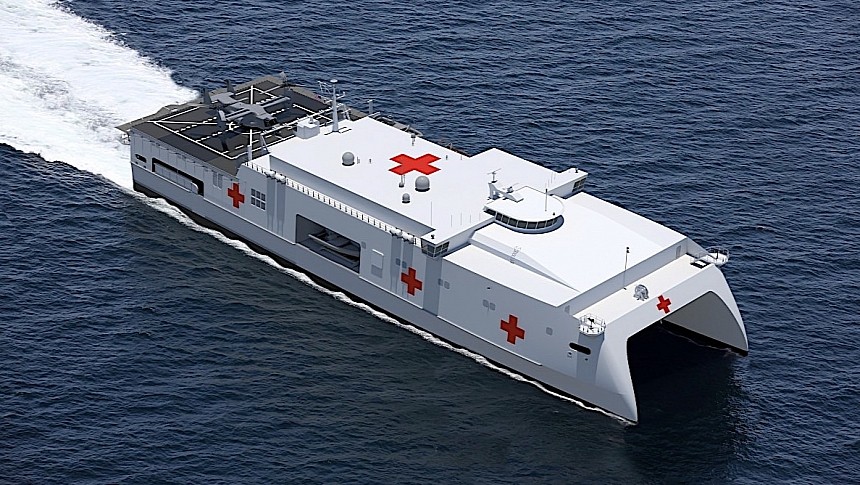Over the past couple of years or so our world seems to have gone down the wrong path in more ways than one. The biggest challenges we face now that the global pandemic has all but been forgotten are the two big wars raging on our planet.
It's unclear whether the conflicts in Ukraine and Gaza will spill beyond their borders or if new hot spots will ignite elsewhere on the planet, but the reality remains the world's militaries are preparing for such scenarios.
The most visible way they do that is by investing heavily in armament production and development. But other aspects of getting ready for war, including ensuring the wounded are well taken care of, are not neglected either.
As 2023 is about to come to a close, one of Australia's largest military shipbuilders, Austal, announced it has received a contract from the U.S. Navy to build no less than three floating hospitals.
The vessels are officially called Expeditionary Medical Ships (EMS), and will be based on a platform Austal calls Expeditionary Fast Transport ship (EPF). In its standard configuration, the EPF stands at 103 meters (338 feet) long, and can travel at speeds of 40 mph (65 kph) for as much as 1,380 miles (2,200 km).
The platform can carry 600 short tons of cargo to where it needs to go, and the U.S. Navy already has 13 of them in operation. The 14th, USNS Cody, is on the way, and this one will partially be capable of medical operations as well. Two more EPFs are in the early stages of construction.
In the EMS configuration, the ship will continue to be just as capable, but will add all the things fields hospitals usually come equipped with, including patient holding, stabilization, evacuation and transport.
The three EMS ships, technically aluminum catamarans, will be configured to have a shallow draft, allowing their access to more ports. They also come with a flight deck that allows landing for helicopters, including the V-22 Osprey and CH-53K. The ships, however, will not carry any weapons on their own.
According to Austal, the build process for the three floating hospitals will only begin after the remaining three EPFs are finalized. It's unclear exactly when that will be, and we also don't know when the actual medical ships will be ready for operation.
According to Austal, the U.S. Navy will spend a total of $867.6 million to have the three hospital ships made. That price of course does not include equipping the vessels with the medical hardware they need for proper operation.
According to available data, the first of the new ships will be called USNS Bethesda (EMS 1). It will be 361 feet (110 meters) long, and its range will be greatly increased compared to the platform it is based on, standing at no less than 5,750 miles (9,260 km).
The most visible way they do that is by investing heavily in armament production and development. But other aspects of getting ready for war, including ensuring the wounded are well taken care of, are not neglected either.
As 2023 is about to come to a close, one of Australia's largest military shipbuilders, Austal, announced it has received a contract from the U.S. Navy to build no less than three floating hospitals.
The vessels are officially called Expeditionary Medical Ships (EMS), and will be based on a platform Austal calls Expeditionary Fast Transport ship (EPF). In its standard configuration, the EPF stands at 103 meters (338 feet) long, and can travel at speeds of 40 mph (65 kph) for as much as 1,380 miles (2,200 km).
The platform can carry 600 short tons of cargo to where it needs to go, and the U.S. Navy already has 13 of them in operation. The 14th, USNS Cody, is on the way, and this one will partially be capable of medical operations as well. Two more EPFs are in the early stages of construction.
In the EMS configuration, the ship will continue to be just as capable, but will add all the things fields hospitals usually come equipped with, including patient holding, stabilization, evacuation and transport.
The three EMS ships, technically aluminum catamarans, will be configured to have a shallow draft, allowing their access to more ports. They also come with a flight deck that allows landing for helicopters, including the V-22 Osprey and CH-53K. The ships, however, will not carry any weapons on their own.
According to Austal, the build process for the three floating hospitals will only begin after the remaining three EPFs are finalized. It's unclear exactly when that will be, and we also don't know when the actual medical ships will be ready for operation.
According to Austal, the U.S. Navy will spend a total of $867.6 million to have the three hospital ships made. That price of course does not include equipping the vessels with the medical hardware they need for proper operation.
According to available data, the first of the new ships will be called USNS Bethesda (EMS 1). It will be 361 feet (110 meters) long, and its range will be greatly increased compared to the platform it is based on, standing at no less than 5,750 miles (9,260 km).






